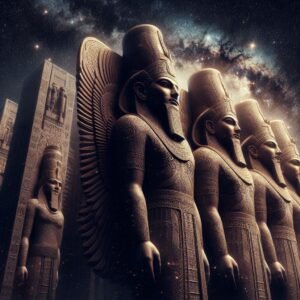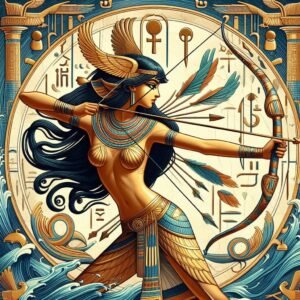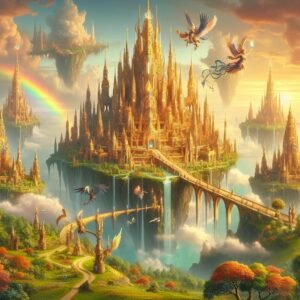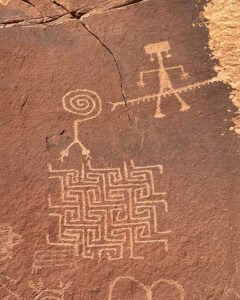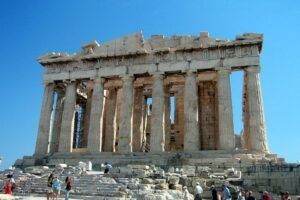
Utu, also known as Shamash in Akkadian, is the ancient Mesopotamian sun god. He was revered as the god of justice, truth, and protection for travellers. Utu was believed to see everything that happened during the day, making him a divine judge. He was the son of the moon god Nanna (Sin) and the goddess Ningal, and the twin brother of Inanna (Ishtar). Utu was particularly venerated in the cities of Sippar and Larsa, and his symbol was the solar disc.
Myths
Utu appears in several Mesopotamian myths, often as a helper or protector. In the myth of Dumuzi’s death, Utu helps protect Dumuzi from the galla demons trying to drag him to the underworld.
Dumuzi, also known as Tammuz, is a significant figure in Mesopotamian mythology, often associated with fertility and shepherds. One of the most famous stories involving Dumuzi is his descent into the underworld. In the myth “Inanna’s Descent to the Underworld,” Inanna, the goddess of love and war, is pursued by galla demons after she escapes from the underworld. To save herself, she allows the galla demons to take Dumuzi as her replacement.
In Mesopotamian mythology, the realm of the dead, often referred to as the underworld, is depicted as a dark and dreary cavern located deep beneath the earth. It is a place where the deceased continue a shadowy version of life on earth. The only sustenance available is dry dust, though family members of the deceased would pour sacred mineral libations from the earth for them to drink.
The underworld is ruled by the goddess Ereshkigal, who resides in the palace Ganzir. Her consort, Nergal, sometimes shares this role. The underworld is guarded by a gatekeeper named Neti, and various demons, including the galla, inhabit this realm. Despite its bleakness, some texts suggest moments of feasting and rejoicing among the spirits, particularly upon the arrival of notable figures.
The galla demons are fearsome entities from the underworld, known for dragging their victims to the realm of the dead. They are described as relentless and merciless, knowing no food or drink, and never experiencing the joys of life. Dumuzi’s capture by the galla demons symbolizes the cycle of life and death, as he spends part of the year in the underworld and part of the year with Inanna, reflecting the changing seasons.
The Afterlife
Mesopotamians had a rather grim view of death and the afterlife. They believed that after death, souls would descend to the underworld, a dark and dreary place known as the “land of no return.” This realm was ruled by the goddess Ereshkigal and her consort Nergal. The dead were thought to lead a shadowy existence, eating dust and drinking from puddles.
Despite this bleak outlook, Mesopotamians also believed in the importance of proper burial rituals and offerings to ensure the deceased’s spirit could rest peacefully. Family members would pour sacred libations and offer food to the dead to sustain them in the afterlife. The concept of an afterlife was not seen as a reward or punishment but rather a continuation of existence in a less vibrant form.
The Epic of Gilgamesh
In the Epic of Gilgamesh, Utu, the sun god (known as Shamash in Akkadian), plays a crucial role in aiding Gilgamesh and Enkidu during their quest to defeat Humbaba, the guardian of the Cedar Forest. Humbaba is a fearsome monster appointed by the god Enlil to protect the sacred forest. Before embarking on their journey, Gilgamesh and Enkidu seek Utu’s blessing and assistance, as the Cedar Forest falls under his domain. Utu grants them permission to enter the forest and provides them with his divine protection and guidance.
The Cedar Forest in the Epic of Gilgamesh is a mythical and sacred realm, often associated with the gods of Mesopotamian mythology. It is described as a magnificent and lush forest, filled with towering cedar trees. This forest is guarded by the fearsome demigod Humbaba, who was appointed by the god Enlil to protect it.
The Cedar Forest represents both a physical and symbolic challenge for Gilgamesh and Enkidu. It is a place of great beauty and danger, embodying the unknown and the wild. The journey to the Cedar Forest is arduous, and Gilgamesh receives oracular dreams from the sun god Shamash (Utu) along the way, which guide and reassure him. The forest itself is depicted as a divine realm, emphasizing the significance of their quest and the bravery required to confront Humbaba and cut down the sacred cedar trees.
As they venture into the forest, Utu’s support is vital in overcoming the challenges they face. His presence reassures them and boosts their confidence, knowing they have the favour of a powerful deity. When they finally confront Humbaba, Utu’s intervention helps them subdue the monster, allowing Gilgamesh and Enkidu to achieve their goal of cutting down the sacred cedar trees. This victory demonstrates their bravery and strength and solidifies their bond and sets the stage for the subsequent events in the epic.
Inanna and An
In the myth “Inanna and An,” Utu, the sun god and brother of Inanna, plays a crucial role in helping his sister acquire the Eanna temple. Inanna, a prominent goddess of love, war, and fertility, desired to control the Eanna temple, which was originally dedicated to the sky god An. Utu’s assistance was pivotal because he supported Inanna’s ambitions and facilitated her acquisition of the temple. This myth highlights the familial bonds among the gods and the dynamics of power and influence in Sumerian mythology.
The Eanna temple, located in the ancient city of Uruk, became a significant centre for the worship of Inanna. This story underscores Inanna’s determination and strategic alliances, which were essential for her to consolidate power and expand her influence. The myth also reflects the broader themes of divine intervention and the interplay between different deities in Mesopotamian religious narratives.
These stories highlight Utu’s role as a just and benevolent deity, aiding heroes and gods alike.
Subscribe to our post updates - Don't miss a thing!!


